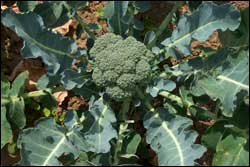Cancer, Genes And Broccoli – Study Of Genetic Differences In Cancer Protection

’Super’ broccoli developed by traditional plant breeding methods
People who gain less protection from cancer by eating broccoli may be able to compensate for the difference in their genetic make-up by eating ‘super broccoli’, a variety with higher levels of the active plant chemical sulforaphane, or by eating larger portions.
Lead scientist on the new research, Professor Richard Mithen of the Institute of Food Research (IFR), said: “Eating a few portions of broccoli each week may help to reduce the risk of cancer. Some individuals, who lack a gene called GSTM1, appear to get less cancer protection from broccoli than those who have the gene.
“Our studies suggest that this may be because if you lack the gene you cannot retain any sulforaphane inside your body, it is all excreted within a few hours. However, if you consume larger portions of broccoli, or broccoli with higher levels of sulforaphane, such as the ‘super broccoli’, you may be able to retain as much sulforaphane in your body as those who have the gene. Eating larger portions may have additional benefits since broccoli is also a rich source of other vitamins and minerals”.
Broccoli is the main source of natural compound sulforaphane. It belongs to the crucifer family of plants which includes the brassica vegetables cabbage, cauliflower and Brussels sprouts, and the closely related Chinese cabbage and turnips. Other crucifers include watercress and salad rocket. The most distinctive characteristic of crucifers is that their tissues contain high levels of glucosinolates. When they are eaten, glucosinolates are broken down to release isothiocyanates. There is a well established body of evidence to show that isothiocyanates are among the most potent dietary anticarcinogens known.
Sulforaphane is the main isothiocyanate derived from broccoli. ‘Super broccoli’ contains 3.4 times more sulforaphane than standard varieties. It has been developed by traditional plant breeding methods.
Fifty per cent of the population lack the GSTM1 gene. While these people may gain less cancer protection from consuming broccoli, it is likely that they gain more cancer protection from eating other types of crucifers, such as cabbages and Chinese cabbage. So the best advice is to eat a mixture of crucifers.
This research was funded by IFR’s Core Strategic Grant from the Biotechnology and Biological Sciences Research Council and by the University of Nottingham and Seminis Inc. It is part of ongoing research at IFR to identify the optimal levels of a range of food compounds for human health.
Media Contact
All latest news from the category: Life Sciences and Chemistry
Articles and reports from the Life Sciences and chemistry area deal with applied and basic research into modern biology, chemistry and human medicine.
Valuable information can be found on a range of life sciences fields including bacteriology, biochemistry, bionics, bioinformatics, biophysics, biotechnology, genetics, geobotany, human biology, marine biology, microbiology, molecular biology, cellular biology, zoology, bioinorganic chemistry, microchemistry and environmental chemistry.
Newest articles

Superradiant atoms could push the boundaries of how precisely time can be measured
Superradiant atoms can help us measure time more precisely than ever. In a new study, researchers from the University of Copenhagen present a new method for measuring the time interval,…

Ion thermoelectric conversion devices for near room temperature
The electrode sheet of the thermoelectric device consists of ionic hydrogel, which is sandwiched between the electrodes to form, and the Prussian blue on the electrode undergoes a redox reaction…

Zap Energy achieves 37-million-degree temperatures in a compact device
New publication reports record electron temperatures for a small-scale, sheared-flow-stabilized Z-pinch fusion device. In the nine decades since humans first produced fusion reactions, only a few fusion technologies have demonstrated…





















